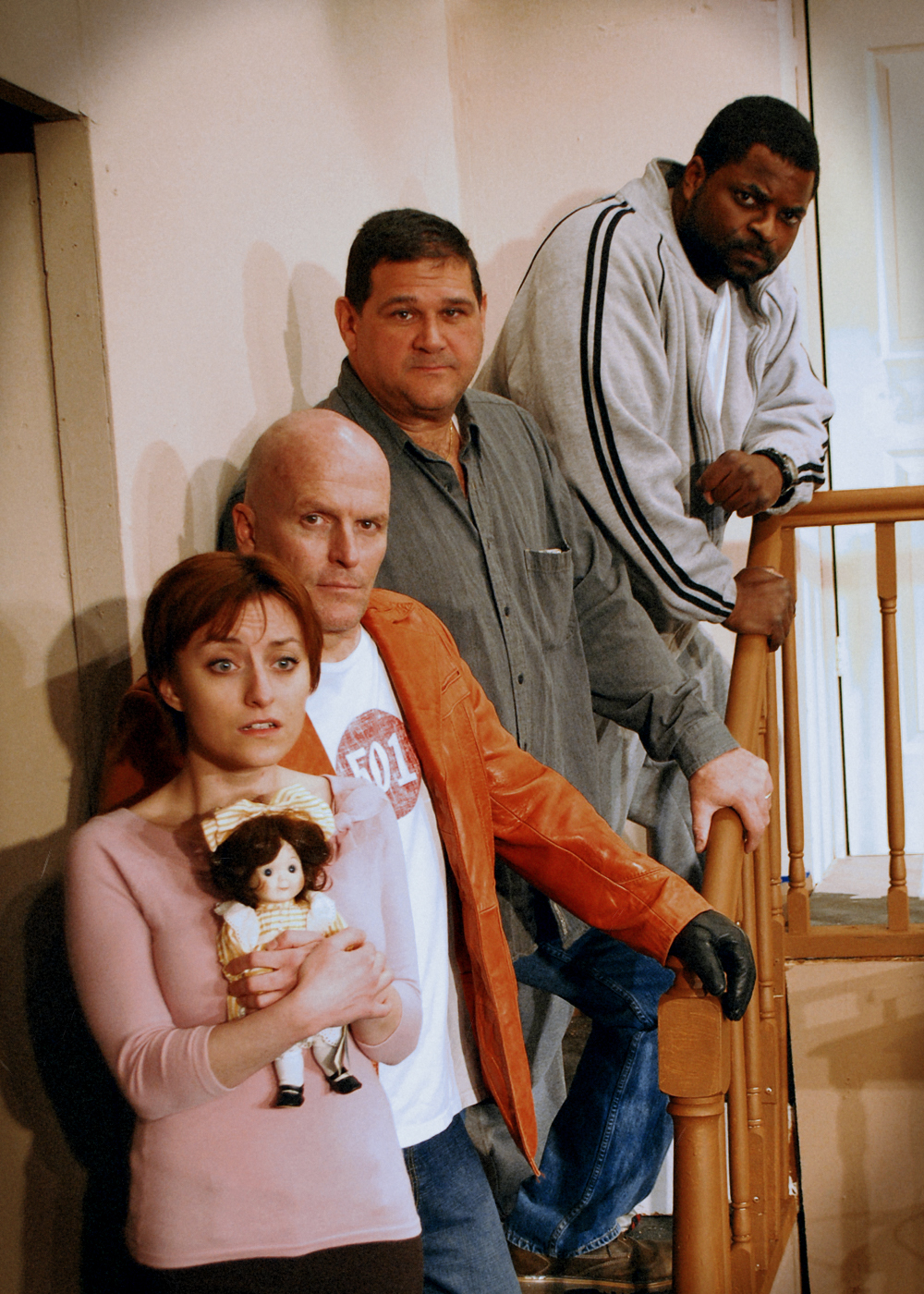The late Frederick Knott was a playwright who knew how to write a “boo!” play. He not only wrote WAIT UNTIL DARK, the Village Players of Hatboro’s current production, but he was also responsible for Dial M for Murder as well. It’s no coincidence that both successful plays also became highly successful movies—WAIT UNTIL DARK has an impressive place on the American Film Institute’s list of “100 Years, 100 Thrills,” and the Master himself, Alfred Hitchcock, took on directing duties for the film adaptation of Dial M for Murder. Director Ron Green’s game and talented cast bring WAIT UNTIL DARK to life in high style, and if the production doesn’t quite erase memories of the 1967 film, all involved succeed in making audiences (and at least one reviewer) jump.

Top to Bottom: James Royale, John Agostinelli, Jerry Neville, Angie Schlauch in Village Players of Hatboro's WAIT UNTIL DARK through March 26.
Knott knew that a thriller, much like a farce, is all set-up and payoff. Three creepy guys are after something that’s hidden in a doll, and in true suspense-classic fashion, we’re not even sure what it is (Hitchcock defined the “McGuffin” as the thing everybody is chasing after, but nobody in the audience cares about). The doll has wound up in the Greenwich Village apartment (convincingly designed by director Green) of Susy Hendrix, the plucky, blind (and, therefore, of course, pretty vulnerable) young wife of a photographer. The creepy guys will do anything to get the doll, and our thriller machine is set in motion. Part of the fun of a thriller is letting the audience catch on to some of the details without letting them predict everything. For example, when one character warns another about how sharp a kitchen knife is, we know that knife is going to have a use in the play besides slicing bread. And that long speech about how to defrost a refrigerator? Trust me, that’s going to turn out to be pretty important, too. But unless you know the story already, you’re not going to know just how those details are going to pay off, and I’m certainly not telling. Suffice it to say there’s a good reason the management warns you that some of the play is played in complete blackness.
In general, you don’t necessarily look for deep characterizations and performances in a “boo” play—and, despite Audrey Hepburn getting an Oscar nomination for the movie, you don’t really get those in the film, either. It’s a pleasant surprise, and a credit to Green’s direction, that the cast manages to create some interesting characters without slowing down or derailing the “boo!” train. John Agostinelli and James Royale, as two low-level con men hoping for the big score, establish a strong camaraderie from the start. Even if you’ve met these characters in any number of cop shows, Agostinelli and Royale present two real hard-luck guys with whom you can almost sympathize, and their reactions when they start to realize that Susy is a lot sharper than they suspected are funny and true, thus upping the suspense ante considerably. Jerome Neville has a field day as the crooked ringleader, bringing appropriately flamboyant brio to a character who likes to play characters—each performance-within-a-performance is a matter of life and death. Young Samantha Tomasi, as Gloria, the brat-with-a-heart-of-gold who lives upstairs, seizes the stage like an old pro with a vivid performance refreshingly free of the cutes. Steve Underwood plays Susy’s husband Sam with a cagey combination of love, support, and slightly off-putting micromanagement—there are some not altogether pleasant undercurrents to the relationship that one wishes Knott would have found time to explore further. That, however, to paraphrase Stephen Sondheim, would make this train a local, and a thriller needs to be an express.
In the end, though, the play is going to rise or fall with its heroine. As noted before, the movie boasted Audrey Hepburn, and Broadway’s Susy was Tony-nominated Lee Remick in 1966. Susy gets a star entrance, and perhaps the best way to sum up Angie Schlauch’s performance is that she earns that star entrance. We see Susy’s natural ebullience as well as her not-always suppressed panic—not just the panic that the events of the play bring to her, but the everyday panic of trying to be “the world’s champion blind person.” Schlauch’s face registers all the details she has to process, especially as she’s sniffing out inconsistencies and contradictions in the crooks’ stories, and she brings the audience with her every blind step of the way.
With WAIT UNTIL DARK, the Village Players are ready to take you for quite a thrill ride, and it’s a pleasure to recommend the trip.
WAIT UNTIL DARK
by Frederick Knott
Directed by Ron Green
Assistant Directed by Alexis Newbauer
March 11-26, 2011
The Village Players of Hatboro
401 Jefferson Avenue
Hatboro, PA 19040-6774
215-675-9757
www.thevillageplayers.com


